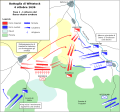Battle of Wittstock facts for kids
Quick facts for kids Battle of Wittstock |
|||||||
|---|---|---|---|---|---|---|---|
| Part of the Thirty Years' War | |||||||
 |
|||||||
|
|||||||
| Belligerents | |||||||
| Commanders and leaders | |||||||
|
|||||||
| Strength | |||||||
| 17,000, 60 guns | 18,000, 32 guns | ||||||
| Casualties and losses | |||||||
| 3,500 dead or wounded, 15 flags | 5,000 2,000 dead, 3,000 captured, 32 guns, 151 flags and baggage |
||||||
The Battle of Wittstock was a big fight during the Thirty Years' War (1618-1648). It happened on October 4, 1636. An army from Sweden, led by Johan Banér and Alexander Leslie, won a major victory. They defeated a combined army from the Holy Roman Empire and Saxony. This army was led by Count Melchior von Hatzfeld and John George I.
Leslie and Banér were in charge of two different armies. Banér led the main Swedish army. Leslie commanded the Army of the Weser. Important officers under them included Lennart Torstenson and James King.
Contents
Why the Battle Happened
The Thirty Years' War Explained
The Thirty Years' War was a long and terrible conflict in Europe. It lasted from 1618 to 1648. It was mainly fought over religion (Protestant vs. Catholic) and power. Different countries wanted to control parts of Europe.
Who Was Fighting?
The Holy Roman Emperor and his allies, including Saxony, were mostly Catholic. They wanted to control northern Germany. They were fighting against Sweden and its allies. These allies were Protestant princes who did not want the Holy Roman Empire to become too powerful. France was also allied with Sweden, but they were not at this battle.
Armies Get Ready
The main army of the Holy Roman Empire was watching the Swedish army. Meanwhile, a smaller Imperial army was taking over areas in Brandenburg. Field Marshal Johan Banér led the main Swedish army. He was joined by Field Marshal Alexander Leslie. Leslie's army included soldiers from Germany, Scotland, and England. Together, they made a surprise move. They crossed the Elbe River and met their enemies. The battle took place in a hilly, forested area near Wittstock.
The Imperial army had more soldiers than the Swedish army. But about one-third of their army was from Saxony. These Saxon units were not as strong. The Swedish army had much better cannons. Because of this, the Imperial commanders decided to stay on top of the hills and defend their position.
The Battle of Wittstock
Choosing a Spot to Fight
The Imperial forces chose to wait for the Swedes on sandy hills called the Scharfenberg. Part of their front line was protected by six ditches. They also had a wall made of linked wagons. The Imperial commanders waited for the Swedish troops to appear in the open fields in front of them.
A Surprise Move
But the Swedish army did not come straight at them. Instead, they moved around the Imperial army's left side. They used a series of hills for cover. This forced the Imperial troops to quickly change their lines. They had to set up a new front to face the Swedes.
The Fight Begins
The battle started with small groups of soldiers trying to secure the hills. Banér's Swedish troops had trouble moving. The ground was marshy and difficult. But soon, the battle was fully engaged along a wide area.
Outflanking the Enemy
Banér and Leslie had sent about a fourth of their army on a long trip. This group was led by Lieutenant-General James King and Major-General Torsten Stålhandske. Their job was to go around the Imperial army's right side. This journey was hard and slow. Because of this, Banér's main troops suffered many losses and started to fall back.
Alexander Leslie moved five of his regiments to help Banér. His Scottish and English regiments fought very hard and took many casualties. But they were able to help Banér in time. Finally, King's cavalry managed to get around the Imperial troops. This caused the Imperial army to break apart and run away.
The Imperial Retreat
Major General Vitzthum, who was in reserve for the Imperial army, refused to join the fight. So, Major-General John Ruthven (Leslie's son-in-law) stepped in. He had been placed there for just such an emergency. Now, the Imperial forces were being attacked from two sides. Their reserve brigades were also fighting. They lost all their cannons. As dusk fell, the Imperial forces retreated completely, running away in a full rout.
What Happened After
The Battle of Wittstock was a huge victory for the Swedish forces. It showed that the Swedes were still a very strong army. Some people thought the Swedes were weak after an earlier battle called Nördlingen in 1634. But Wittstock proved them wrong.
In reports about the battle, Johan Banér gave credit for the victory to Field Marshal Leslie. Leslie, in his own letters, was upset about how many soldiers his army lost. He hinted that he and Banér had disagreed about the battle plan. Another report by James King agreed with Leslie. These reports show how difficult and costly the victory was.
Maps



